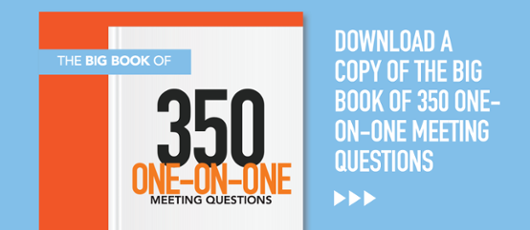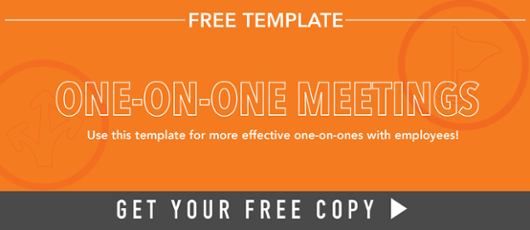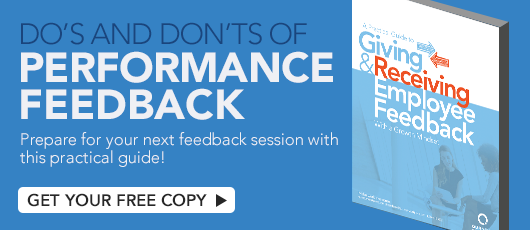One on One Meeting Guide: How to Drive Successful Conversations
One on one meetings are a critical component of employee, team, and business success.
To achieve important business goals, it’s essential for managers and employees to stay connected and aligned. There must be trust, accountability, and ample opportunities for honest feedback. And all of this must be done in a human way that serves employees, managers, and businesses.
But not all 1:1 meetings are created equal. You can’t just do one on ones. You have to do them right.
What is a one on one meeting?
One on one meetings are lightweight, continuous conversations between an employee and their manager, or really any two individuals with shared goals.
1:1 meetings can happen wherever, whenever, and as often as needed—and usually include a mix of formal and informal conversations.
Many people associate 1-on-1s with performance conversations, especially as more and more organizations ditch the performance review in favor of more frequent check-ins. One on one meetings are a great way to discuss performance and goals in real-time—but they can and should be so much more.
When done well, one on one meetings allow managers to:
- Build and strengthen trusting relationships with each team member
- Get and stay aligned on goals and performance
- Help employees tackle challenges and obstacles in real-time
- Work with employees to determine and adjust priorities and areas of focus
- Discuss organizational changes, decisions, or initiatives that impact an employee
- Talk about an employee’s plans for development and growth
Why are one on one meetings important?
One on one meetings are important to employee engagement. Research from Gallup shows that employees who have regular 1:1 meetings with their managers are 3x as likely to be engaged. This is important considering the hefty cost of disengagement.
Our research further supports this idea, showing that 86% of highly engaged organizations use regular manager-to-employee one on one meetings, compared to only 50% of disengaged companies.
One on one meetings are also important to employee, team, and organizational performance: when Adobe switched from annual performance reviews to frequent 1:1s, it saw a 30% reduction in voluntary turnover. GE did the same and saw a 5x increase in productivity.
The data speaks for itself—these meetings are important. They have a big impact on employee, team, and organizational success.
The Impact of One-on-One Meetings on Employee Success
In order for employees to be successful, they need:
- Clarity around their role, expectations, and performance
- Influence over how they accomplish their work
- Support in their day-to-day challenges and obstacles
These important needs cannot be met without regular communication and feedback between employees and managers.
Did you know that managers account for at least 70% of the variance in employee engagement? And that 75% of employees think their boss is the worst part of their job?
Employees want and need better relationships with their managers. And 1 on 1 meetings are an essential component to building those relationships.
1:1s help foster trust and understanding on both sides of the table—and allow managers and employees to quickly tackle issues before they become problems. When conversations happen regularly, managers can spend less time managing and more time coaching toward success.
One on one meetings set the expectation that:
- Meaningful, two-way conversations are the norm
- Any topic is open for discussion
- Both parties can be honest with each other
- Employees have a safe place to share their concerns and open up
They give employees ownership of their own experience and their own performance—and helps them feel like valued contributors rather than subordinate minions.
The Impact of One-on-One Meetings on Team Success
While one on one meetings naturally benefit the two individuals involved, they are also beneficial to the team at large. Each 1 on 1 serves as a piece of the bigger team puzzle, allowing managers to:
- Keep individual team members aligned
- Ensure everyone is contributing how and where they need to be contributing
- Reduce instances of duplicate effort or misalignment
- Help everyone row in the same direction toward bigger goals
- See how the team as a whole is impacting organizational success
The Impact of One-on-One Meetings on Organizational Success
If one on one meetings are happening regularly between every manager and employee, teams are more likely to be aligned, efficient, and focused on bigger goals.
If all teams are operating at this level, it’s likely that the entire organization will follow suit—becoming more aligned, more efficient, and more inclined to meet important goals and KPIs.
Bottom line: One on one meetings help your individuals and teams be successful by keeping everyone connected, aligned, and rowing in the same direction.
3 Common Misconceptions About One on One Meetings
Before we get into the meat of how to conduct effective 1 on 1 conversations, let’s unpack some common misconceptions we’ve heard about one on one meetings.
1. One on one meetings should be easy.
Managers often have good intentions when starting one on one meetings with their employees—but then bow out when conversations don’t go as smoothly as they had hoped.
One on one meetings require effective communication and feedback skills. And for most managers, these are not natural talents—they must be learned and practiced over time. 1:1 meetings are the perfect forum for managers and employees to sharpen their soft skills.
The first few meetings with an employee might feel awkward, clunky, or repetitive. But over time your one on ones should start to build momentum and run more smoothly as both managers and employees get a sense of what they need from each other.
2. One on one meetings will breed unrealistic expectations.
Sometimes organizations are wary of regular one on one meetings because they don’t want to open the door for unrealistic expectations. They ask, “if an employee asks for something that the manager or organization cannot deliver on, how will we manage that?“
Your employees can’t have everything they want—and they know that. But both parties need to be able to communicate their needs and wants to each other.
Employees should feel safe asking for what they need. They deserve to know what is possible and what isn’t. Managers should be able to receive these requests confidently—and communicate what they can or cannot do to help. Approaching employees with this open-door policy encourages employees to ask questions, increases transparency, and helps employees feel valued.
3. Managers need to have it all together.
Managers tend to get into their heads about 1-on-1 meetings. They think they need to know all the answers to every question and fear looking inadequate to their direct reports. But this isn’t true.
Employees know that their managers are human, and they don’t expect managers to have all of the answers to all of their questions all the time.
Here are a few tips for managers who think they need to have it all together:
Prioritize transparency over perfection. Whatever information you can bring to the table is better than no information. You don’t have to know everything about everything.
Don’t try to fix all their problems. This goes against a coaching mindset. Instead ask employees smart questions that guide them to their own solutions. Your job is to support, not solve.
It’s okay to say, “I don’t know.” Sometimes this is the best answer. It gives managers and employees time think through situations without rushing to action.
Focus on listening. Many times, employees just want to feel heard, supported, and understood. The best thing you can do sometimes is to just listen.
The Ideal One on One Meeting Frequency
Managers should have one on one meetings with employees on an as-needed basis, but we recommend quarterly or monthly as the bare minimum. The pace of business is typically more frequent than this and you need to keep up with what is happening while it is happening.
Your one on one meeting frequency should be tailored to the needs of your business and your teams. They might include a mix of:
- Ad hoc check-in meetings as needed
- Recurring weekly check-ins
- Monthly one on one meetings
- Quarterly performance conversations
- Year-end performance review meetings
5 Elements of Effective One on One Meetings
While one on one meetings can and should be personalized to individual needs, there are a few general best practices managers should keep in mind regarding one on one meetings.
1. They're lightweight and specific.
There’s always a lot to talk about, but don’t go crazy. Keep a one on one meeting to five questions or less. Know exactly what feedback you want to share and be prepared to root your feedback in examples. It can be difficult to accept and activate on feedback without a clear, shared understanding between manager and employee.
2. They're fueled by thoughtful preparation.
The best way to ensure managers and employees are equally prepared for a one on one meeting is to launch a collaborative agenda beforehand. Let employees drive the conversation and share your talking points ahead of the meeting. This will reduce anxiety and increase employee buy-in and engagement in the process.
Before the meeting, use multiple data sources to get a sense of where the employee is at. This might include:
- Recent recognition
- Goal progress
- Past one on one meeting notes
- Peer or customer feedback
Take note of recent wins, challenges, and questions to ensure your conversation is relevant, objective, and productive.
3. They run on a regular cadence.
One on one meetings are most effective when they happen regularly. Our research shows 55% of highly engaged organizations hold 1:1 meetings at least quarterly.
Quarterly is better than nothing—but we recommend monthly meetings at minimum. This gives managers and employees the opportunity to address challenges, questions, and concerns as they come up and ensures employees are getting the ongoing support and feedback required for high performance.
4. They require dedicated time, space, and energy.
We know you’re busy. But your employees deserve your full attention during your one on one meetings. Do what you need to carve out enough mental space to be fully present during each meeting. Turn off your laptop, silence your phone, and stay focused.
5. They must end with clear action steps.
Don’t let your precious one on one time be all for nothing. Make sure the meeting ends with clear next steps on both sides. You’ll want to be sure to take good notes throughout the meeting so you can revisit any thoughts in future conversations. Notes allow you to rely on facts and evidence instead of memory—and help you track progress, trends, decisions, and accountability over time.
How to Structure a One on One Meeting
There are a lot of great one on one meeting templates available for a wide variety of topics. One of our favorite templates is the GOOD framework.
The GOOD model focuses performance conversations on:
- Goals
- Obstacles
- Opportunities
- Decisions
This method helps managers engage and motivate employees to take ownership of their goals, opportunities, and results. Here’s how to structure a one on one meeting with the GOOD framework:
Goals
What do you want to achieve? Discuss the current state of goals since your last one on one meeting, analyze progress made on current goals, and plan for new and upcoming goals.
Obstacles
What is standing in the way of your success? Talk through obstacles that might be a barrier to goal completion and overall employee success. This can be anything from lack of resources to conflict with a coworker to an unproductive work environment.
Opportunities
Where do you want to go from here? Discuss employee opportunities for recognition of work, personal and professional growth, and increased job satisfaction.
Decisions
What will be done before our next one on one meeting? Make decisions on what will be accomplished before your next meeting. Decide who will tackle which tasks and recap any new or updated goals.
For maximum impact, make sure employees are involved in the planning process and in creating the one on one meeting agenda. Managers and employees should contribute to the agenda ahead of the meeting so both parties have adequate time to prepare.
One on One Meeting Topics and Questions for Quality Conversations
One on one conversations can be used to discuss a wide range of important topics. Here are a few one on one meeting topics and one on one meeting questions to consider:
1. Goal Setting
To start the year off right, managers and employees should discuss an employee’s performance and goals. This creates alignment between the manager and employee on what work needs to be done in the upcoming year. They can discuss how the employee’s goals contribute to team and organizational goals.
During this time, managers and employees can identify barriers, discuss goals and stretch goals, and determine if any resources are needed to achieve goals.
One on One Meeting Questions for Goal-Setting Conversations
Recommended cadence: quarterly or annually |
2. Performance Check-In
If your organization uses annual performance reviews, monthly or quarterly check-ins allow open and transparent dialogue about an employee’s performance throughout the year. It's important that you keep track of progress, but many leaders don't know how to document their conversation with an employee. Take thorough notes during your meeting and share them with your employees. This makes annual reviews easier to prepare for and prevents employees from feeling blindsided or surprised at the end of the year.
Performance check-ins should be used to discuss:
- Progress and barriers to goal achievement
- Recent recognition and positive feedback
- Areas of opportunity and constructive feedback
- Action items and next steps
One on One Meeting Questions for Performance Check-Ins
Recommended cadence: quarterly or monthly |
3. Career Growth and Development
Career growth and development are important drivers of employee engagement and employee retention. Managers should use career development conversations to understand an employee’s aspirations and interests so they can serve as champions for their employees’ development and growth. This empowers employees to feel ownership for their own development and positions managers as coaches and advocates.
One on One Meeting Questions for Career Development Conversations
Recommended cadence: biannually |
4. Recurring Check-Ins
A quick weekly or biweekly standing one-on-one meeting can go a long way for both managers and employees. Check-ins can be brief and informal. They should allow an employee to share ideas, ask questions, and discuss challenges or concerns. Managers can coach employees and develop trust and safety in their relationship.
One on One Meeting Questions for Recurring Check-Ins
Recommended cadence: weekly or biweekly |
5. Employee Compensation
Employee compensation conversations can be slightly uncomfortable, but managers need to have them regardless. These conversations are prime opportunities to build trust, increase engagement, and improve retention. Managers should come prepared with internal and external compensation data, but also create space to hear employees out on their concerns.
Sometimes compensation needs and wants can’t be solved for immediately, but it’s important that employees feel heard and that managers are transparent and fair in these conversations.
One on One Meeting Questions for Employee Compensation Conversations
Recommended cadence: annually or biannually |
6. Feedback Review
Many teams practice peer-to-peer and 360 feedback, which is a great way for employees to get perspective on their performance aside from their manager’s. But feedback can be a tough pill to swallow. Managers can use one on one meetings to help employees navigate and process feedback and coach them toward meaningful action steps.
One on One Meeting Questions for Feedback Review
Recommended cadence: as needed |
7. New Hire Check-In
When a new or transferred employee joins the team, it’s important to get and stay aligned early. Managers and employees should get to know one another and start building a trusting relationship as soon as possible. New hire check-ins are a good time to discuss role expectations, team dynamics and processes, organizational mission and goals, and alignment.
One on One Meeting Questions for New Hire Check-Ins
Recommended cadence: at 30/60/180 days post hire |
8. Skip-Level One on One
Skip-level one on one meetings help employees connect with other leaders in the organization. These meetings can build trust in leadership, improve alignment on important topics or initiatives, and help employees feel valued. Leaders gain valuable insights about their managers and teams, giving them a big picture view of what’s going well and what needs improvement.
One on One Meeting Questions for Skip-Level One on Ones
Recommended cadence: annually |
9. Performance Improvement Conversation
When an employee fails to meet expectations, performs inconsistently or below average, or is not living out your organization’s core values, a performance improvement conversation may be needed.
These meetings should be used to discuss performance issues, create a performance improvement plan, and agree upon next steps. Having these conversations sooner rather than later can save an employee from termination and ensure the manager is dealing with performance issues head on.
One on One Meeting Questions for Performance Improvement Conversations
Recommended cadence: as needed |
Manager Conversation Guide
Okay, managers this section is for you. Understanding how to have a 1:1 meeting is one thing—but actually having the conversation is another. The most important advice we can give you is to be your authentic self. Your employees will see right through it if you try to be someone you’re not.
Follow the golden rule: treat others how you would like to be treated. Here are some conversation tips to help guide you in your one on one meetings:
1. Be intentional.
One on one meetings should be a valuable use of everyone’s time. Don’t just have a meeting to have a meeting. Be intentional about what you discuss during each encounter. Make your time together efficient and enjoyable, treating every meeting as an opportunity to build trust.
2. Be personal.
Your employees aren’t robots. They are unique humans. Your 1 on 1 meetings are an opportunity to treat them as such. Tailor your meetings to the person on the other side of the table and take the opportunity to really get to know each employee and what makes them tick.
3. Be honest.
It’s best to say what you mean and mean what you say. One on one conversations are meant to help your employees grow and overcome challenges. Adopt a growth mindset—everyone can get better, and no one’s potential is fixed.
4. Be kind.
Feedback can be difficult to give and to receive, but a little bit of kindness goes a long way. Any piece of feedback should come from a place of caring. Be considerate with your delivery in these conversations.
5. Be present.
Both employees and managers are responsible for performance. Managers should take an active role in these conversations. Listen actively. Probe deeper with questions. Keep yourself free from distractions like your phone or laptop.
Making Things Easier With One on One Meeting Software
Your one on one meetings will be most effective if you find the right technology to support your efforts. There's no shortage of vendors out there to choose from, but not all of them will foster productive, ongoing performance conversations that actually boost performance.
Here are some key components to look for in one on one meeting software:
1. Collaborative, easy-to-use tools
Your one on one meeting software should enhance face-to-face meetings and make preparation and follow-up easy. Look for features such as a shared agenda builder, best practice templates, comment threads, and the ability to capture private notes.
2. Connected to employee performance software
It should be easy for managers to pull in data from other performance and engagement tools like recognition, feedback, goals, talent reviews, and past one on one conversations. When managers have the full picture of where an employee stands, they can have smarter, more effective 1:1s.
3. Synced with productivity tools and HRIS
Your one on one meeting software should reduce administrative burden—not add to it. Make sure it connects with your HRIS so it can keep up with shifting teams and people data. Calendar syncing enables automated, recurring one on one meetings to always be on team radars.
4. Nudges and notifications
Busy schedules are the biggest obstacle when it comes to one on one meetings. Look for one on one meeting software with in-tool and email notifications that notify employees and managers when 1 on 1 meetings are launched, shared, or archived so they never miss a beat.
5. Intuitive manager/employee dashboards
Managers and employees should be able to see upcoming and past 1 on 1 meetings all in one place. This makes it easy to reference notes and talking points from previous conversations as you prepare for the next conversation. Managers can keep track of all of their individual conversations in one convenient conversation hub.
6. Insightful analytics for leaders
While one on one meetings are a manager- and employee-driven initiative, we know how important it is for HR and leaders to understand what’s happening at a high level. One on one meeting analytics help admins easily see activity and progress in real time.
Conclusion: One on One Meeting Tips
We’ve talked about a lot when it comes to one on one meetings. Here’s a quick summary of do’s and don’ts to keep in mind:
Do
|
Don't
|
One on one meetings are a critical component of any performance management strategy. Tackle your next one-on-one meeting with confidence with our Big Book of 350 One on One Meeting Questions.











